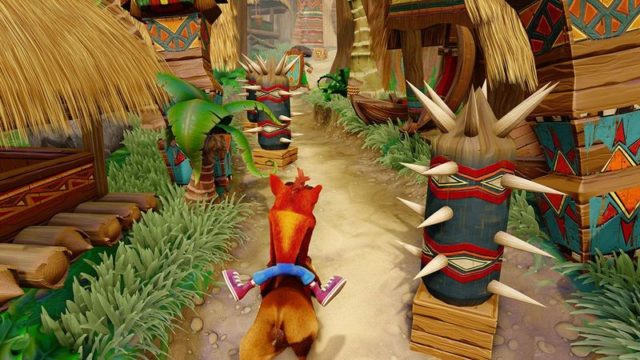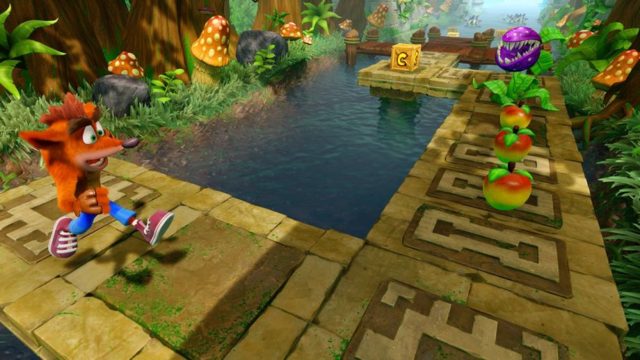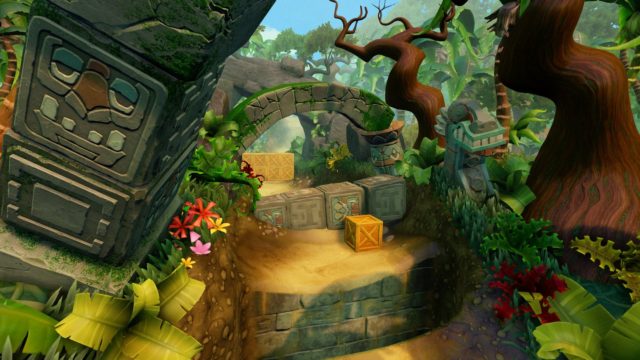Excellent recreation of the first three Crash Bandicoot games; presentation values are top notch; gameplay is precise and insanely fun
Not especially innovative as a platformer, as the objectives and challenges are very straightforward; difficulty level and lack of tutorials might be too much for some to handle
While it’s not as though this is the first time that Crash Bandicoot has been on a Nintendo platform, the same can’t be said of his original trilogy of games. The first three Crash Bandicoot games (Crash Bandicoot, Crash Bandicoot 2: Cortex Strikes Back, and Crash Bandicoot: Warped) were all PlayStation exclusives back in the late 1990s. Developed by Naughty Dog, the studio that would go on to helm the Jack and Daxter, Uncharted, and The Last of Us franchises, Crash was ostensibly the third member of the mascot war that raged between Mario and Sonic for so many years. This initial trio of games represents the pinnacle of the series, which is likely a big part of the reason that Activision, the current holder of the Crash franchise, elected to have developer Vicarious Visions recreate them with updated graphics and other tweaks for the current console generation. Crash Bandicoot N. Sane Trilogy has been out since last year, but now the game officially has come to Nintendo Switch.
For those who have never played these original Crash games, there might be some confusion as to what all the fuss is about. Which makes sense, as everything that came out after the Naughty Dog trilogy has been hit or miss in terms of quality. So much so that it’s not unreasonable to suggest that prior to N. Sane Trilogy, the Crash series had lost some of its luster. Think of Sonic and the spotty reputation that character has become saddled with and that’s essentially where Crash found himself. Thankfully, by going back to the earliest days of the series, Vicarious Visions was able to utilize not just the cream of the Crash Bandicoot crop, but also some of the best platformers of the era in order to reinvigorate the franchise.
Crash Bandicoot began to take shape back in 1994. Designers Andy Gavin and Jason Rubin were the co-founders of Naughty Dog and in the middle of moving the company to Los Angeles from Boston. While making their way across the country, the two men began looking in-depth at the then-contemporary design trends in the video game market, in particular arcades. They came to believe that 3D was the direction the industry was moving towards and wanted to develop a 3D platformer for a home console. Sony’s system was without a mascot at that point, and in a case of fortuitous timing, things worked out so that Crash Bandicoot came to be the de facto face of PlayStation. That was 1996, months before Super Mario 64 would hit stands alongside the launch of Nintendo 64.
The reason I’m bringing up this bit of history is because it’s a key piece of the puzzle for those trying to understand what the original three Crash Bandicoot games represent. They’re 3D, but in a rough, rudimentary way. When Mario 64 showed up, it completely rewrote the book on 3D gameplay. The sense of depth, the way Mario moved, the camera system, all of it was revolutionary. Crash Bandicoot certainly exists within a 3D environment, but it’s more limited and simplistic by comparison. The camera is always focused squarely behind Crash and remains stationary throughout each game. The courses themselves are also little more than corridors, with some branching paths for variety. So although both games released within the same year and are both considered 3D platformers, they’re really pretty different experiences.

Which isn’t a bad thing! I noted above that these are some of the best platformers of the era for a reason: they’re very good. They’re just not necessarily the sea change that something like Super Mario 64 was. So, set your expectations accordingly. With that said, what makes these games so fun and worthy of a remaster? Well, let’s break down what makes the first Crash trilogy unique within the series. As I mentioned above, these original three titles aren’t fully 3D. Movement is restricted to the four cardinal directions and diagonals. This means Crash runs into the screen and away from it, and side to side. That’s not too different from what players are used to these days, but the key difference rests with the camera, which never leaves Crash’s back (save for some 2D sections). This stationary viewing angle is what makes the movement so precise in N. Sane Trilogy.
Unlike in later series installments and other 3D platformers, by always focusing the action on Crash, it allows players to concentrate on timing their jumps properly and sticking their landings. Think about a game like Super Mario 64; while it certainly was an intuitive experience, the camera made it so that part of the challenge was getting it into a position where Mario wouldn’t miss a ledge and hurtle down to his death. N. Sane Trilogy doesn’t have that problem. The action is always centered and easy to follow. What’s more, the actual mechanics of Crash’s run, jump, spin, and slide are pinpoint accurate and precision balanced. It wasn’t just happenstance that Crash was put into the same tier as Sonic and Mario when he debuted. The three games that comprise N. Sane Trilogy are arguably as lovingly and methodically produced as some of the best entries of either of those two characters’ adventures— or at least just a notch below.

Still, as fun as the games are, there’s no denying that they’re not especially innovative. I will come short of saying that the use of 3D in these titles is gimmicky, because in truth it was an impressive technical feat that Naughty Dog created on PlayStation. It’s reminiscent of Klonoa and its 2.5D perspective in that it takes 3D and does something unique with it to enhance the gameplay. That said, there’s no denying that N. Sane Trilogy’s trio of Crash games aren’t the most innovative platformers out there. The first game, in particular, is a fairly straightforward take on running, jumping over hazards, and bopping baddies. It’s all well done but doesn’t bring a lot of “new” to the table beyond the use of 3D. Even the remaining two games don’t up the ante so much that I’d call them evolutionary leaps compared to the original.
I would also point out that the original Crash Bandicoot might compel some people to put their foot through the TV screen. It is, without exaggeration, home to some of the most ridiculously challenging platforming stages ever created. Vicarious Visions pulled a Grezzo and reproduced the original three Crash games down to the smallest details. That includes some of the insane levels that sent many a PlayStation player into conniptions back in the day, like Sunset Vista, The Lab, and others. N. Sane Trilogy is fascinating in that the first Crash Bandicoot is so notoriously brutal at times that Vicarious Visions actually suggests that players get their feet wet with the other two games before trying the first one! I find myself on the fence as to whether or not the difficulty of some of those stages is owed to requiring better skills… or poor design. Anyone who reads my writing knows I’ll cop to a lack of ability on my part, so take that as you will.

The remaining two Crash titles demonstrate a bit more polish and restraint, along with different gameplay segments to break things up a bit. It’s pretty crazy playing N. Sane Trilogy and thinking that the studio which would go on to create The Last of Us also made an all-ages, cartoony platformer. It’s a testament to Naughty Dog and the studio’s incredible creativity and vision that these titles are still so fun all these years later. It’s also a testament to Vicarious Visions’ own high level of ability that they were able to recreate the first three Crash games in such a manner that they feel refreshed and authentic all at the same time. N. Sane Trilogy looks stunning in handheld mode and plays just as well. When docked, the resolution does bump up, but it’s nevertheless not quite as visually sumptuous as on PlayStation 4 or Xbox One. It’s nothing that should be deal-breaking, but it’s something that graphics nuts might be disappointed with.
That leaves us with one final question: should those who played these games back on PlayStation bother with N. Sane Trilogy? Yes! A thousand times, yes! The graphical boost is marvelous, to the extent that even those who still have their original jewel cases and discs will want to see the 2018 version of these golden oldies. I’ll go so far as to say that replaying these titles has revealed to me that the concept and mechanics of the original trio of Crash games is still as fresh in 2018 as it was in 1996. I do think that for novices, however, there might be a bit of a learning curve in that N. Sane Trilogy is ruthless in its quest for authenticity; meaning, the difficulty levels haven’t been touched and there aren’t really any tutorials to speak of. I think learning how to play these games is pretty straightforward, but there might be some out there who can’t take the heat. In any event, this is a collection of games that fans of platformers won’t want to miss. It’s also a great introduction to the character and series for those who’ve never before dipped their toes into the Crash pond. For Switch owners looking to expand their library of games yet again, N. Sane Trilogy can’t be missed.
Nintendojo was provided a copy of this game for review by a third party, though that does not affect our recommendation. For every review, Nintendojo uses a standard criteria.




 ShareThis
ShareThis





